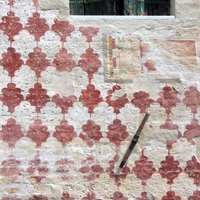
Treviso Urbs Picta
research project
Treviso urbs picta is a collective, multidisciplinary research project which the Fondazione Benetton Studi Ricerche launched at the end of 2011. The aim, starting of course with a survey of all available bibliographical and archival resources, was to identify and then to conduct an iconographic and stylistic analysis of the frescoed and otherwise decorated facades of houses and other buildings within the walls of the city of Treviso.
Research focused not only on surviving frescoes and facades painted between the 13th and 21st centuries but also on those which are documented but have been wholly or partially lost.
Painstaking study and innumerable field surveys led to a comprehensive and systematic dating and cataloguing campaign, including the updating of previous explorations of the subject and the creation of a new synchronic and diachronic topographical map dedicated to the decorated facades of Treviso. The overall approach featured careful attention to developments in successive historical periods and included an appraisal of the works’ current state of conservation and the various emergency situations they face, together with proposals designed to ensure the safeguarding of this particular heritage involving restoration and awareness-raising.
The paramount objective of Treviso urbs picta, from the beginning and in common with the many other research projects that the Foundation has devoted to the city of Treviso since it was established, was that its execution, results and publication should enrich scientific knowledge of the subject and enhance civic awareness of the cultural heritage of Treviso and its community.
Research project working group for the Fondazione Benetton Studi Ricerche
Lionello Puppi (1931-2018, scientific supervisor, member of the Foundation’s Scientific Committee), Patrizia Boschiero (coordinator, head of the Foundation’s publications department), Rossella Riscica (researcher, architect), Chiara Voltarel (researcher, art historian), Massimo Rossi (head of the Foundation’s map library), Marta Modesto (researcher, cartography), Nicoletta Tesser (editor at the Foundation’s publications department, bibliography); a specific database for the project was designed and set up by Andrea Mancuso and Thomas Lorenzon.
The first and fundamental result of the long process of research, selection and organization of the data collected was Treviso urbs picta. Facciate affrescate della città dal XIII al XXI secolo: conoscenza e futuro di un bene comune (216 pages, 244 colour illustrations and 36 in black and white, edited by Rossella Riscica and Chiara Voltarel, and published jointly by the Fondazione Benetton Studi Ricerche and Antiga. The Italian edition came out in 2017 and a parallel English language edition was published in 2018 with the sub-title Frescoed facades of the city from the 13th to the 21st century: knowledge and future of a common good.
The volume and its editors received the Special Jury Prize at the 2019 Giuseppe Mazzotti Gambrinus Awards.
Complementary and structurally linked to the volume is the open access database trevisourbspicta.fbsr.it, which comprises the results of the research into the frescoed buildings of Treviso, extant and not, and also the treasure-store of photographs taken by Arcangelo Piai and Corrado Piccoli whom the Foundation commissioned to document the present condition of all surviving painted decoration on the facades of buildings within the city walls of Treviso. The page for each of the 614 buildings documented contains images, descriptions, historical and stylistic data, information about the state of conservation of the decorations and much more. Links between the research data and six different current and historical maps, from the Napoleonic cadastral map to the latest photomap, makes it possible to create many interesting “theme maps”. And 20 search filters can be used singly or jointly to bring up groups of buildings with common historical, architectural, cadastral features and decorations linked by subject, dominant colour, state of conservation and other characteristics. The geolocation of each building also enables anyone who lives or works in Treviso and even those just passing through, scholars and connoisseurs of the subject to track down specific frescoes and tap into their history and the collective memory they are part of.
At the end of 2019, the Foundation’s project and the work of researchers Rossella Riscica and Chiara Voltarel caught the imagination of Marina Grasso, which in turn led to the Treviso Rotary Club adding a new initiative designed to raise awareness of this aspect of cultural heritage in the form of themed tours in Treviso urbs picta: a series of audio-guided walks accessed through the app. izi.TRAVEL, each an aid to the rediscovery and appreciation of these beautiful frescoed facades, their background and meaning and in relation to the history of the city. This application can be accessed, free of charge, through any smartphone, tablet or computer, directly online or downloading in advance so as to be able to listen to the contents offline. The tours wind through the streets and squares of the old city, introducing various aspects of the painted facades, decorations and buildings of different historical periods and styles, encouraging a general view and pointing out details that might not otherwise be noticed. A trip through old Treviso, starting with the Middle Ages, passing through the Renaissance and on through more recent periods to our own time.
